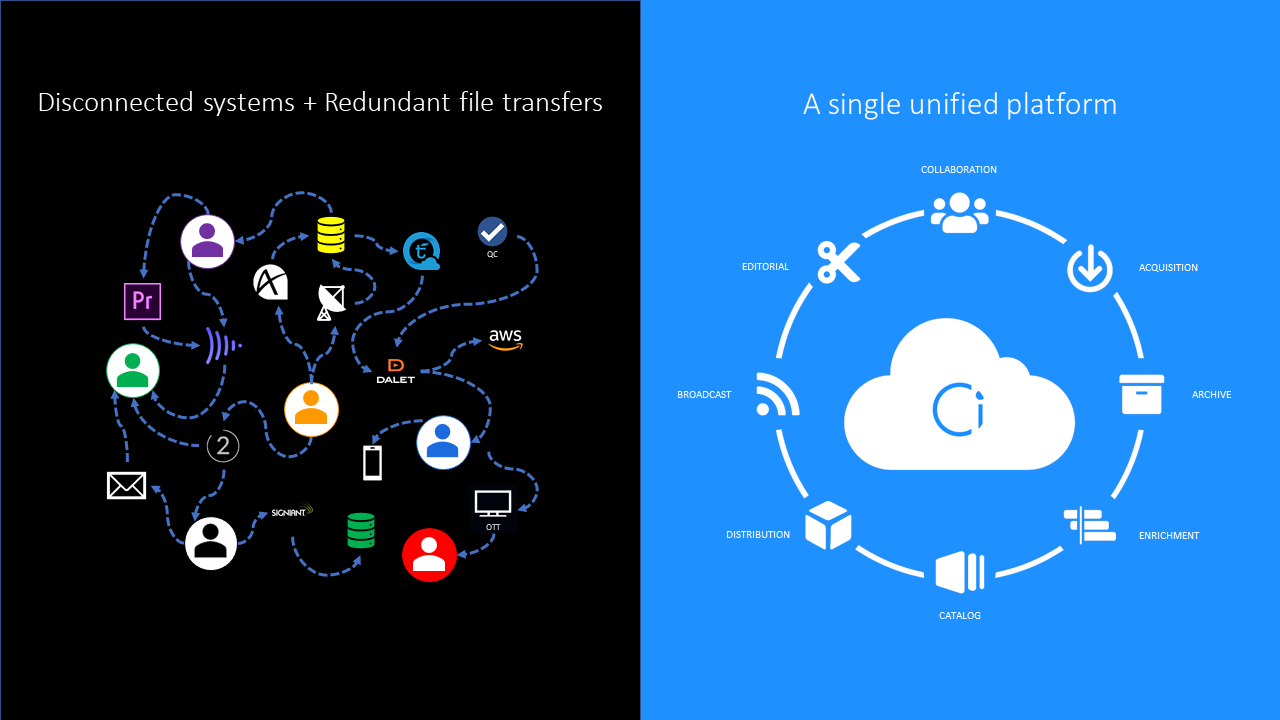Cloud-Based Workflows Helping To Collapse On-Prem Media Silos, says Sony’s David Rosen
Alternatives like Sony’s Ci cloud solution directly address the needs of today’s remote media workforce

Sponsored Content from Sony
Change in media workflows is undeniable. Spurred on by many technical developments, easy access to the cloud and most recently by the impact of the pandemic, which accelerated acceptance of allowing media professionals to work remotely, the transition away from working in traditional ways on-premise has gained significant momentum.
One of the technologies enabling production houses, post facilities and broadcasters to jettison their siloed media workflows in favor of a cloud-based SaaS alternative is Sony’s Ci media cloud platform.
I recently interviewed David Rosen, vice president of cloud applications and solutions at Sony Electronics Professional Solutions Americas, about how workflows are changing and the role Sony Ci in this ongoing transition.
Q: What new demands face today’s enterprise-level media management workflows that may not have been considerations in the days of traditional, siloed media workflows?
David Rosen: One of the biggest trends forcing the collapse of silos is the rise of remote work. Having on-prem silos located in a few places where the majority of the workforce was physically congregated may not have been ideal, but it was manageable. However, having workers spread out and off-network makes that a big problem. Copying files to insecure locations with limited storage capacity over slow networks doesn’t scale. Couple that with the collapsing of rights windows and the need for social media amplifications in real time and you realize that linear, time-boxed access to content is unacceptable. Content needs to be accessible for omni-channel use faster than ever.

Q: In some respects, this reminds me of MovieLabs’ 2030 Vision for the evolution of media creation. Do you agree?
DR: Entirely. Getting content in front of audiences has become a challenge of speed and efficiency. By securely storing the content in as few locations as possible and bringing the processing and creativity to the content, teams save valuable time and money while making their workflows significantly more secure. This is the future of content creation and distribution.
Q: How is Sony’s Ci cloud platform for media workflows tackling these demands?
DR: Ci has brought together five things every media organization needs into a single solution that can be accessed from anywhere while keeping the content centrally stored in a single location. Ci provides accelerated file transfer, real-time collaboration, asset management, transcoding and archive. Since Ci supports a Bring Your Own S3 model, customers can point Ci to their own S3 buckets. This means that content can be managed by Ci while also being accessed by any other applications or workflows that need it. Access can be administered by the Ci API or provided directly via AWS access controls since the customer owns the bucket. This model gives companies the flexibility to use the tools of their choice without being constrained to the tools Ci provides. Workflows happening outside of Ci can access the content in place, eliminating the need to move it. That is the core of what we are helping customers achieve: maximum workflow with minimum file movement.
Q: Often, I think Ci is thought about in the context of production and post-production. Can it play a role in broadcasting where station groups wish to share content among their individual stations?
DR: Ci started with an early focus on post-production to enable teams to capture, review and provide feedback remotely. But very early in our journey, broadcasters and station groups began to use Ci as a secure way to share files. Today Ci is used by the largest broadcasters and station groups in the world to centralize acquisition of content from anywhere – whether it’s uploading files in real time using camera-to-cloud, capturing live streams or enabling journalists to upload directly from their phone or computer. Since Ci has its roots in secure file sharing, stations use Ci to share content with each other safely and simply. This simplicity of gathering and sharing content has led many groups to move their entire archives into Ci to enable secure access and management from anywhere. Others have incorporated Ci into their broader supply chains, with Ci as the central repository from where their master control automatically pulls content to air. The flexibility of Ci and the speed at which customers can begin using it has proven very attractive to station groups.
Q: Have you found concerns about the safety of media assets stored and shared in the cloud to be an impediment to consideration or adoption of cloud-based media workflows?
DR: It certainly was an issue when we started ten years ago but those days are long gone. In fact, the perception has flipped 180 degrees. The truth is that bad actors are constantly finding new ways to breach systems, and protecting critical infrastructure has become an ever-escalating arms race with massive dollars at stake. On-premise infrastructure and custom-built software has become a real liability from a security perspective. Public cloud and SaaS providers’ sole business is to provide secure, scalable infrastructure and applications. They spend billions of dollars a year and hire the brightest minds in the world to provide that. By moving to the cloud, media organizations directly benefit from that investment and are able to stay focused on their core mission of creating and distributing world class content rather than building and defending core infrastructure.
Q: What role can Ci play in advancing the transition of broadcasters from racks of dedicated devices through a hybrid of these existing solutions and their virtual equivalents in the cloud to a future that’s all or nearly all cloud?
DR: The industry is certainly moving towards a 100% cloud-based future, but it will take some time to get there. Ci is an ideal solution to help companies start that journey. It provides the capabilities all media companies require in a cloud-native SaaS solution that can be directly integrated with on-premise workflows when needed. Ci’s REST API is used to bridge hybrid workflows and to make it simple and cost effective to move content between the cloud and on-premise locations. Built-in storage management policies allow content to transition automatically to lower cost storage tiers after periods of inactivity and automated restore capabilities make sure it is quickly available when needed. Smart Clipping also allows organizations to have access to their entire archives and clip out only what they need – helping to reduce unnecessarily large file transfers. Ci also has transfer utilities that can reside on premise and allow content to be automatically uploaded to or retrieved from the cloud. The most valuable first step broadcasters can take is to get their content stored in the cloud so they can be primed to respond as quickly as possible to new market opportunities. Ci enables them to do that with literally zero delay or implementation.
For more information or to book a Ci demo, please visit our website.
About Sony
Sony’s Ci Media Cloud is a media-centric suite of cloud services with innovative applications that empower media companies and teams of all sizes to streamline production, post production, creative, and delivery workflows. Adopted by Hollywood studios, indie filmmakers, television shows, broadcasters, sports and news companies, Ci connects people, content, and devices around the world to transform and streamline the creative process. Ci’s REST APIs and event based architecture enable seamless integration with other applications and creation of hybrid and cloud-native workflows. For more information, visit www.sonymcs.com.
The professional video industry's #1 source for news, trends and product and tech information. Sign up below.
